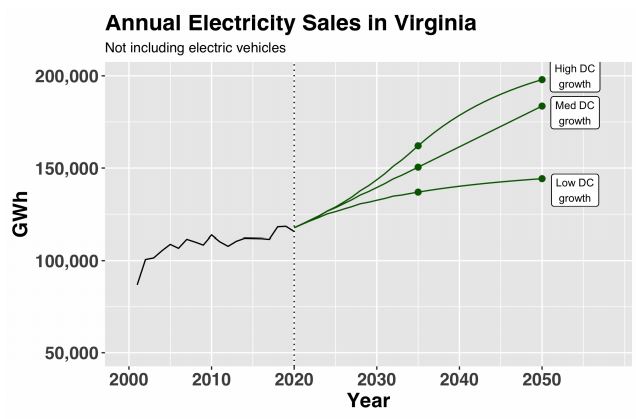 Boom times ahead for electricity. Electricity demand in Virginia will grow 30%, give or take, over the next 15 years as more energy-consuming data centers are built and more Virginians drive electric vehicles, writes Bill Shobe, a University of Virginia professor who supports the transition to a net-zero-carbon electric grid, in a new report. Electricity use could grow by more than 78% by 2050, the state’s deadline for achieving net zero. The increase will occur despite gains in energy efficiency that have flattened electricity demand growth in recent years.
Boom times ahead for electricity. Electricity demand in Virginia will grow 30%, give or take, over the next 15 years as more energy-consuming data centers are built and more Virginians drive electric vehicles, writes Bill Shobe, a University of Virginia professor who supports the transition to a net-zero-carbon electric grid, in a new report. Electricity use could grow by more than 78% by 2050, the state’s deadline for achieving net zero. The increase will occur despite gains in energy efficiency that have flattened electricity demand growth in recent years.
Where will all that power come from?
Relicensing the nukes. Dominion Energy’s four nuclear units at the Surry and North Anna power stations produce about one-third of the utility’s electricity. The units, originally designed to last 40 years, are licensed to operate another 20 years. Dominion is seeking regulatory approval to extend the licenses yet another 20 years. The Nuclear Regulatory Commission staff has recommended granting that approval for the two Surry units. But some environmentalists are opposed.
John Cruickshank, an executive committee member of the Virginia chapter of the Sierra Club, expressed concerns, according to the Richmond Times-Dispatch. “The nuclear power plants in Virginia were originally designed to operate for 40 years. Many people who are familiar with nuclear power do not believe that they can safely generate electricity for twice as long,” he said. “The reactor core and other equipment weaken over time and there is an increased chance of serious malfunctions. This is particularly a concern at the North Anna Power Station, which experienced a significant earthquake in 2011.”
Dominion is ramping up. The Virginia Clean Economy Act calls for 16,100 megawatts of solar or onshore wind to be proposed or in operation by 2035 — assuming the nukes will be relicensed. Three days ago the State Corporation Commission approved nine solar facilities totaling 500 megawatts, according to Dominion. The company now has 5,200 megawatts of solar in operation or in development. Meanwhile, Dominion is seeking proposals for another 1,000 megawatts of solar, onshore-wind, and energy-storage projects, the company announced last week.
But… so is resistance to utility-scale solar. Proposals for several utility-scale projects have been rejected by county boards. Most recently, the Culpeper County Board of Supervisors unanimously voted down a 149-megawatt project on 1,700 acres proposed by Strata Solar. Strata had doubled the money from the siting agreement it would pay the county from $1 million to $2 million and agreed to more than $200,000 in machinery in tools taxes. But preservationists, some of whom had fought a losing battle against Dominion to upsize transmission lines through the county, made forceful pleas for preservation of the county’s “pristine farm country.”
Bacon’s bottom line: The General Assembly can mandate a net-zero electric grid by 2050. Dominion and Appalachian Power Co. can plan for a net-zero electric grid by 2050. Independent developers can comb the landscape looking for solar-farm locations. But will county boards of supervisors give the needed approvals?
What happens if Shobe is right and electricity demand increases 78% by 2050, environmentalists manage to scuttle the Surry and North Anna license renewals, and solar developers can’t get approval for enough sites to add another 11,000 megawatts of solar?



